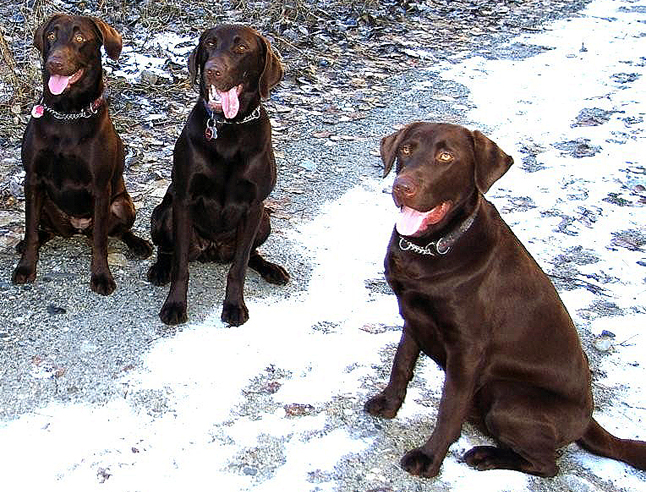
By Barbara J. Little
Revelstoke dogs are being poisoned. As word flashed around town many dog owners I talked to jumped to the same conclusion I did, that some heartless cretin was intentionally luring dogs with strychnine-laced meat or some other irresistible bait.
The weekend of April 16 two dogs from Revelstoke and one from Salmon Arm fell critically ill after ingesting toxic substances. After talking to two vets and the RCMP the consensus seems to be that the culprits are Mother Nature, and us.
“We’ve received no complaints about dogs being intentionally poisoned,” said RCMP Corporal Rod Wiebe. “We rely on the veterinarians to give us evidence, and I can confirm at this time that no complaints have been received.”
“Because the dogs came from three completely different areas, and had similar substances in their stomachs or vomit, I think we’re seeing poisoning from toxic vegetation, particularly coarse grasses,” explained veterinarian Jim Clark of the Shuswap Vet Clinic in SA.
Revelstoke vet Lisette Valdamanis agrees with Clark, “I have zero suspicions that we are dealing with someone intentionally poisoning dogs. That glaze of white you see on last year’s grass is mold,” explained Valdamanis, “and it can be deadly.”
“Just like our ancestors craved fresh greens in spring like dandelion, which they used medicinally and as nutritional supplements, dogs crave their own tonic, new grass,”
Clark said. “Unfortunately molds ingested from vegetation and food stuffs can induce tremorgenic mycotoxin toxicity (TMT).” In lay terms, an attack on an animal’s nervous system.
Potentially lethal toxins can be found in a host of decomposing substances; feces (which many dogs love to gobble) and very dead critters such as mice, snakes, birds, fish, and large carcasses like deer.
In an article Clark sent me, Linda Shell, DMV (neurology) explains the symptoms of TMT. She says a small amount of ingested tremorgenic mycotoxin can cause fine muscle tremors of a dog’s face, ears, eyelids, and/or ataxia – confusion and inability to coordinate voluntary muscle movements. Increased exposure causes severe tremors, seizure and possible death.
A dog thus poisoned will be seen to be twitching, staggering, have a glazed look and may convulse, and will not likely have gastrointestinal upset, ie vomiting or bloody stools and diarrhoea. If your dog experiences these symptoms, get him to the vet immediately, or call for advice as one Revelstoke dog owner did.
“There were lengthy delays on the west on the Trans Canada Sat, April 16, due to repairs on the Malakwa Bridge,” said Clark. “The owner of one of the Revelstoke dogs exhibiting symptoms of TMT couldn’t get to Salmon Arm so called in and I was able to assist him to induce vomiting.” That quick action probably saved the dog’s life as the disease manifests quickly, within half an hour to two hours said Clark. All three dogs survived.
According to Shell, tremorgenic mycotoxins are found in a range of food stuffs mainly moldy dairy products, moldy walnuts and peanuts, stored grains and moldy garbage and compost.
“A compost that is not “hot” enough can produce deadly molds on a variety of food stuffs, including coffee grounds and fermenting cottage or cream cheeses,” said Clark.
To be safe follow the rules of successful composting – put no oils, meats, fats (cheeses), or cooked table scraps into your bin. And if there are dogs running in your neighbourhood, cover the compost securely. The dog you poison might be your own.
Clark also said he has treated dogs with severe symptoms from marijuana poisoning as some people think it’s cool to deliberately feed dogs recreation drugs and watch them get stoned. “In August we start to see dogs sick from ingesting common mushrooms that grow on lawns,” Clark said.
If you suspect poisoning of any sort and can’t get to a vet, the American SPCA has an animal poison control centre. “For a fee, you can talk to a veterinarian 24/7 who will give advice for poisoning,” said Valdmanis. The poison control centre number is 1-888 426-4435. Consult fee, $65. Your pet’s life, priceless.
The ASPCA website lists the top 10 toxins from the 167,000 calls they received in 2010 as follows; human medications, insecticides, rodenticides, people food, vet meds, chocolate, household toxins, indoor and outdoor plants, herbicides and outdoor toxins.
It also clarified that yes, raisins, grapes, onion and garlic can be lethal to dogs, if enough is consumed.
According to Cheryl Hermansen at Home Hardware, society is going green and reducing and replacing the use of harmful substances. “We’re phasing out products laced with poisons like strychnine and warfarin,” said Hermansen. “There are now pet-friendly antifreezes and rodent poisons. We carry Green Earth products made from powdered corn cobs that are not dangerous to pets.”
Dogs will be dogs. They love to run off leash and they love to eat crap. Clark’s best advice, “If you want to keep your dogs safe, keep them leashed, or within range, and pick up their poop wherever you walk.”
To which I’ll add: be prepared to sprint over and extract suspicious substances from your dog’s mouth (owning a Lab, affectionately known as ‘pig dogs’ or ‘bottom feeders’, I’m doing a lot of sprinting!); keep vet and poison control numbers handy; get a good canine first aid book; google Dog Poisoning and educate yourself – the list of potential poisons for dogs is staggering.
And finally, most important, report any suspected intentional bait poisoning of dogs to the vets, RCMP or Crimestoppers.
Barbara J. Little is a regular contributor to The Revelstoke Current



